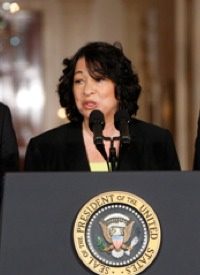
We can no doubt anticipate an explanation that will go something like this: when the judge said “policy,” she did not mean legislative or executive policy. She was talking about the making and the following of precedents and how the court deals with or “develops” the law according to the interpretations and applications of the law where the law and the precedents intersect. It is no doubt a good deal more complicated than we might think from listening to a sound bite on YouTube.
Okay, but what about this “development of the law” idea? As the judge said, at the district court level, the judge is applying the law to the facts and “the facts control.” But on a court of appeals, the judge is following and developing “precedent.” How the court has in the past applied the law, not to precisely this case, assuming this particular case has not come to the court before, but to other cases like it. Thus the judge must take into account not only the facts of the case and the law and existing precedent, but how a ruling one way or another may affect future cases — an entire “class of cases,” as Sotomayor put it.
In other words, if in a certain case, the facts and the law point to a particular outcome, the judge will think about the effect of that outcome on the development of precedent in the “class of cases” and how it will affect “the next step in the development of the law,” said Sotomayor. Think about that. It could explain a lot about the ruling made by Sotomayor and her colleagues in the case of the New Haven, Connecticut, firefighters who claimed to be discriminated against in promotions.
The firefighters had passed an exam as candidates for promotion, but none of the African-American candidates did. So in the name of fairness and in a move that might be called affirmative inaction, the local authorities threw out all the results and made no promotions. The firefighters sued and their case was dismissed in U.S. District Court. So they appealed to the Second Circuit Court in New York City. There a three-judge panel appeal promptly and unanimously dismissed the appeal. Sonia Sotomayor was one of the three judges.
The whole issue of affirmative action or, in this case, inaction, is bound to raise some dust in the hearing room and in the memories of the senators. It calls to mind the hotly controversial race in North Carolina nearly 20 years ago. Sen. Jesse Helms ran against affirmative action and had an ad on the airwaves showing a pair of white hands tearing up a letter of rejection because, according to the ad, the man had lost out on the job or promotion to an affirmative action candidate of a legally favored race. It happened that Helms, a Republican, was running against a black man, Harvey Gant, the Democratic nominee. Helms won the election, but was pilloried by the pundits for the allegedly racist ad.
But suppose the man whose hands appeared symbolically in the ad had, in fact, been discriminated against for being Caucasian. Or English-speaking. Or Irish or Catholic or Puerto Rican, or whatever. Does Sotomayor believe that when such a case reaches the court of appeals, where the facts, apparently, no longer “control,” such a case should be judged less on its merits and the rights of the appellant and more on the effect it will have on the “class of cases” to which it belongs? If the appellant has been wronged, his rights violated, and his livelihood threatened or diminished, should the wrong be enshrined in precedent because the judge or judges believe that would be the optimum “next step in the development of the law”?
It is part of the American creed, well expressed in the language of our Constitution, that rights adhere to each person and not to constituent groups. Judge Sotomayor, who is a conspicuously successful member of an ethnic minority, appears to bring “group think” to her revision of “the equal protections of the law.”
Her defenders will no doubt argue that by not overturning the District Court decision, Sotomayor and her colleagues were actually exercising judicial restraint. That is meant to confute and frustrate anticipated charges by Republicans that the lady is a judicial activist, legislating from the bench. How can she be a judicial activist if in the most notable case against her, she is being blamed for not overturning a decision reached by a lower court? Conservatives can’t have it both ways.
Liberals can, of course. Remember when liberals complained about a pro-life “litmus test” for Supreme Court nominees? They appear quite comfortable with a “pro-choice” litmus test by which any nominee who holds that the Roe v. Wade ruling of 1973 is not true and righteous altogether does not belong on the high court. Beyond that, Obama is clearly playing the Latina version of the “race card.” Here we have the first African-American president elevating a Puerto Rican woman to be the first Latin American on the U.S. Supreme Court. If you oppose that, you must be un-American.
That is clever, especially when you consider that Latinos, unlike black voters, sometimes vote Republican in large numbers. Republicans hope they will in 2010 and 2012. Republican opposition to the first Latin-American nominee to the Supreme Court will not be helpful in that regard. But Republicans have a card of their own they can play, if they have the temerity to use it. Call it the fairness card. Better yet, the justice card. White males of European ancestry are not the only victims of reverse discrimination. Latinos, Mexicans, and others are sometimes caught up in its net. One of the New Haven firefighters whose case was dismissed is Hispanic American. The Republicans should find that man.
And make him a hero.
Related article:
Judge Sonia Sotomayor’s Shadowy Thinking
Photo: AP Images



